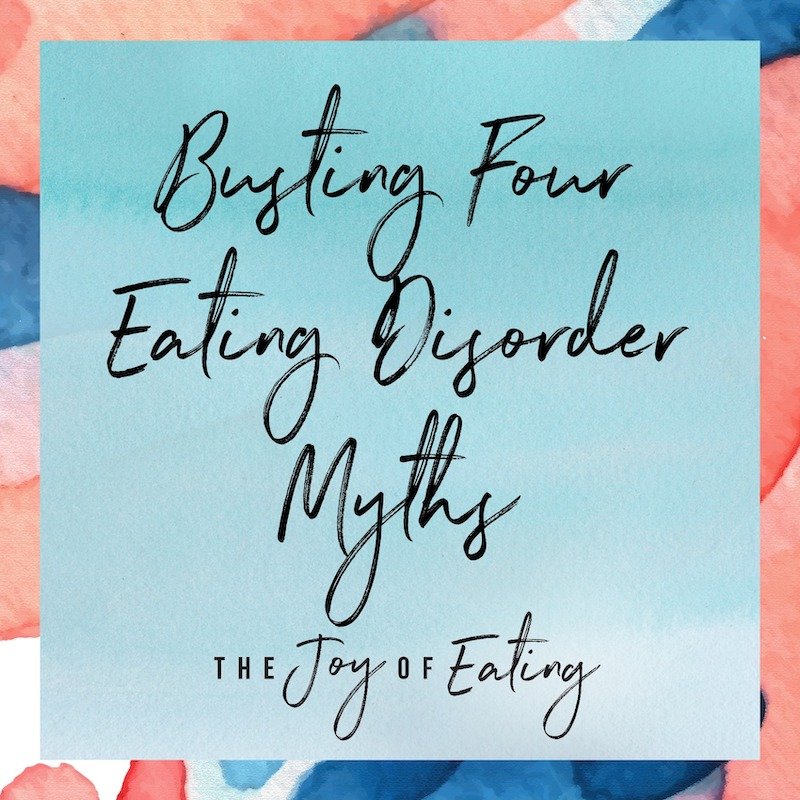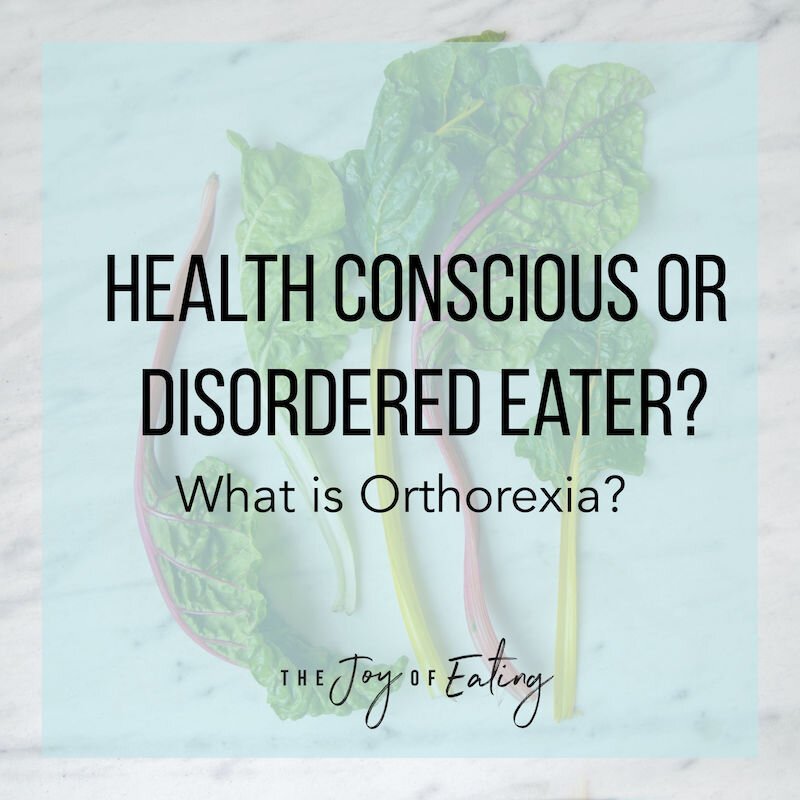Intuitive Eating in Eating Disorder Recovery
“You can’t practice intuitive eating in eating disorder recovery” is a common refrain in treatment. But is that actually true? In this post, I discuss the 10 principles of intuitive eating and how they can be incorporated in eating disorder recovery.
When I first started training in intuitive eating, I was warned that it isn't appropriate for people who have an active eating disorder. Initially, I couldn't explain why, but it always rubbed me the wrong way. Still, I deferred to the experts, and even put off getting more in depth training in eating disorder work, because I really loved working with intuitive eating and didn’t want to stray from that path.
In the 8+ years since then, I’ve gotten A LOT more training and experience in both intuitive eating and eating disorders. I now see this myth as well intentioned, but problematic. Let’s discuss…
Why do people say you can’t practice intuitive eating in eating disorder recovery?
There's a few reasons why people say you can't use intuitive eating in eating disorder recovery. The first is that in eating disorder recovery, meal plans are often necessary to help with nutritional rehabilitation, aka the process of renourishing the body (and very likely regaining lost weight) after a prolonged period of restriction. Meal plans are also use to help normalize eating patterns and make sure someone is eating adequately throughout the day. Types of meal plans can vary, ranging from more structured, like exchanges, to less structured patterns, like a plate plan. How much structure is needed varies from person to person, based on their individual nutrition and mental health needs, as well as the dietitians approach. Regardless, a structured meal plan is usually thought to conflict with the idea of intuitive eating, a paradigm where you listen to your hunger and fullness cues to guide eating.
Second, hunger and fullness cues are all sorts of wonky when you have an eating disorder, especially early on in the recovery process. This is true for all eating disorders. For example, people with anorexia might feel extremely full from a very small amount of food, or may not experience hunger cues at all, despite desperately needing more food. People with binge eating disorder or bulimia may struggle with recognizing more subtle signs of hunger and fullness, as they often wait until they are extremely hungry before eating, then eat to the point of uncomfortable fullness. Intuitive eating is designed around the fact that typically, hunger and fullness cues line up pretty closely with one’s energy needs. But if hunger and fullness cues aren’t reflective of your needs, how can one utilize that paradigm?
A third reason intuitive eating is warned against in eating disorder recovery is that many people need an amount of food that is much, much more than they might expect. When malnutrition is present, you need to eat enough to fuel your body for the day, plus pay back the nutritional debt that’s accrued through long periods of restriction.
As you can see, there’s very good reason to be cautious with intuitive eating when someone is in recovery. And yet, that doesn’t mean that intuitive eating isn’t a tool that can be utilized in healing from an eating disorder.
What’s the problem with saying you can’t do intuitive eating in eating disorder recovery?
When someone says you can’t practice intuitive eating in eating disorder recovery, they are basing that advice off a simplistic (and false) idea of what intuitive eating is. By ignoring eight of the 10 principles of intuitive eating and focusing on hunger and fullness, it turns intuitive eating into what we in the field like to refer to as “the hunger fullness diet.” Yes, it is true that someone in eating disorder recovery usually can’t rely on hunger and fullness cues, but intuitive eating is much more nuanced and complex than eating according to the hunger and fullness scale.
Intuitive eating was designed as a series of 10 principles that are meant to be tools, not rules. These principles are meant as guidelines that can be adapted to each individual person utilizing the paradigm. Saying someone with an eating disorder can’t practice intuitive eating implies if they can’t follow a principle to the “t” or follow all the principles of intuitive eating, then they can’t practice intuitive eating. This reinforces the very rigid, binary thinking that so many people with eating disorders struggle with.
It’s also really discouraging. As I started working with clients in recovery, they often shared how upset they felt about being told intuitive eating was off limits. When people learn about intuitive eating, many immediately connect with its message, and see it as a way out of the rigid, restrictive way of feeding themselves that they’re trapped in. Learning about intuitive eating can be so incredibly freeing, and helps people visualize a way of feeding themselves outside of the eating disorder. To be told they cannot use this tool can be a bit of a gut punch.
When we work with clients in eating disorder recovery, we integrate pieces of intuitive eating right from the beginning. One of the ways we do that is by adapting the principles of intuitive eating to where a client is at in their recovery process. Below I will share the principles of intuitive eating and how they can be integrated into eating disorder recovery.
(P.S. If you need a refresher on the 10 principles, read my intro to intuitive eating blog post)
The 10 Principles of Intuitive Eating in Eating Disorder Recovery
Reject the Diet Mentality
Obviously, it's quite challenging to reject the diet mentality when you're trapped in an eating disorder. But you can begin to challenge diet mentality by learning more about intuitive eating and Health at Every Size. Read books like Intuitive Eating and Anti Diet. If social justice is important to you, it may be helpful to read books like What We Don't Talk About When We Talk About Fat to learn more about fatphobia, and Fearing the Black Body to understand the racial origins of our cultural body standards.
Part of rejecting the diet mentality is also learning abou the negative health effects of restriction, and for those who struggle with binge eating disorder or bulemia, understanding how restriction often leads to binging. The NEDA website has helpful information on the health consequences of eating disorders, or for more in depth information, read Sick Enough, a fantastic book written by a doctor who specializes in the treatment of eating disorders.
Honor Your Hunger
If you have an active eating disorder, you might not experience hunger cues, or you might only experience them when you’re at an extreme level of hunger. Because of this, honoring your hunger in recovery means feeding your body at consistent times or intervals established by you and your dietitian. Following your meal plan is honoring your hunger, even if you’re not feeling hungry.
Another way you can work on honoring your hunger in recovery is by feeding yourself outside of designated eating times if you feel physical hunger cues. While a recovery plan is designed to provide you with enough food to fuel your body and pay back the nutritional debt that’s accrued, some days you may feel especially hungry and need more energy than what’s on your meal plan. And of course, if you’ve restricted on your meal plan, it’s likely you’ll experience hunger before your next meal or snack time. This is one way to practice flexibility, an essential component of intuitive eating, even if you are on a structured meal plan. I’ll add that advice also applies to people who have binge eating disorder or bulimia (although part of recovery will be distinguishing emotional hunger from physical hunger) and people who are in a bigger body.
Make Peace With Food
In intuitive eating, this principle is all about giving yourself permission to eat foods that were previously restricted. In recovery, this looks like reintroducing fear foods and doing exposures. This is a huge part of eating disorder treatment at pretty much every level of care, so I love to share with clients who have been told they can’t practice intuitive eating in eating disorder recovery that they already are!
Challenge the Food Police
While making peace with food involves eating fear foods, challenging the food police involves unlearning the unhelpful and inaccurate information about food that fuels eating disorder thoughts, and chipping away at the moralizing around food choices (i.e. thinking you’re “good” or “bad” for eating one way or another). With this principle, it’s helpful to learn about food and nutrition in a more flexible way (shameless plug: check out my book Gentle Nutrition for that!). It’s also helpful to practice mindfulness to notice when the food police pop up so that you have a chance to challenge or reframe those thoughts.
Respect Your Fullness
For people with anorexia, this is perhaps the least accessible principle of intuitive eating. Most people will feel very full from a small amount of food, much less than what’s required to treat the underlying eating disorder. Plus, digestive issues are extremely common and it can be hard to know if a sensation is fullness or stomach upset.
One thing we stress to our clients, whether they have an eating disorder or not, is that there are situations where hunger and fullness cues are not reliable. For example, if you’re feeling extremely stressed, part of the stress response can be lower levels of hunger hormones and reduced appetite. We remind them that intuitive eating is listening to your body and brain to guide eating decisions. While your body might be signaling fullness, intuitive eating and honoring your hunger means following your meal plan.
For those with bulimia and binge eating disorder, learning to tune into your fullness cues and identify what it feels like to be satisfied, but not stuffed, is an essential part of recovery. Of course, eating consistently and adequately throughout the day is a prerequisite for this. If you are not eating enough, it will be near impossible to stop at a point of comfortable fullness. Eating almost always feels stressful and chaotic when you are at a primal level of hunger.
Discover the Satisfaction Factor
When you have an eating disorder, pleasure is generally the last thing you’re thinking about with food. This is also true with binge eating disorder. Despite the belief that binging is about pleasure or “gluttony,” that is absolutely not the case. Restriction usually triggers binging, and the experience is generally so disconnected and emotionally intense that it is not at all pleasurable.
Many people we work with in recovery are limited by food fears. Other times they have spent so long eating what they think they “should” be eating, that they have no idea what foods they like. We start integrating the satisfaction factor by simply practicing asking what they are in the mood for.
If you’re struggling with an eating disorder, it might feel scary to eat something enjoyable. There’s often a fear of getting “out of control” and eating too much. As you heal, eating satisfying meals and snacks will help you feel calm and less chaotic, and stop obsessing about food all the time. By meeting your physical and emotional needs with food, you’ll finally be able to turn off the obsessive thoughts about food.
Cope With Your Emotions With Kindness
Another principle of intuitive eating that is an essential part of eating disorder recovery. People with eating disorders use either food or restriction as a way to cope with intense, uncomfortable emotions. In recovery, you’ll learn to feel your feelings, tolerate distress, and build a toolbox of coping skills you can turn to.
Respect Your Body
It’s often said that body image is the last thing to heal when you are recovering from an eating disorder. I think that’s pretty accurate. Many people think that in order to practice intuitive eating, you can’t hold any desire for weight loss. This would basically cross off everyone who has an eating disorder, plus like most people in general. Thankfully, that’s not the case. The principle of respect your body is all about treating your body kindly, regardless of what you think about it. That’s basically the aim of recovery. The end of the tunnel isn’t loving every single thing about your body - it’s respecting and treating your body kindly because no matter how you feel about it, y’all are in it together for the long haul.
That said, body image work is an essential component of eating disorder treatment, as well as intuitive eating. It looks different for everyone depending on your needs, background, etc. If you'd like some additional support around body image, I highly recommend the books The Body is Not an Apology and More Than a Body.
Movement- Feel the Difference
For many people in eating disorder recovery, part of uncoupling exercise from calorie burning and dieting is taking a pause from exercise. For others, especially those with medically unstable eating disorders, exercise restriction may be mandated by a treatment team. For those who want to integrate movement in a safe way during their recovery, there is more evidence as of late that integrating it early in the process is safe, and may even be beneficial. Check out Safe Exercise at Every Stage, which is a really helpful resource in determining how movement can be safely integrated into your recovery process.
Honor Your Health with Gentle Nutrition
In my book, Gentle Nutrition, I make the argument that the most important aspect of nutrition is whether you're eating enough food - eating enough calories, carbs, fats and proteins to support your body. This principle of intuitive eating is often interpreted as being about eating more nutritious foods, and certainly that can be part of gentle nutrition, however I think that interpretation simplifies what nutrition actually is. In eating disorder recovery, nutrition focusses first on adequacy, treating any underlying nutrient deficiencies, and using nutrition to help navigate complications of the refeeding process (like GI issues). When you are in eating disorder recovery, meeting your meal plan IS gentle nutrition.
As you’re reading through these principles of intuitive eating for eating disorder recovery, I hope a theme that is standing out is that the principles are a series of tools, not rules. How those tools are used, and in what order, can look different from person to person. Eating disorder or no, everyone tackles intuitive eating a little bit at a time. There's no shame in starting with some principles that are more available for you in the moment, and then moving on to the harder stuff as you're ready.
If you’re looking for support in integrating intuitive eating into your recovery, my team and I provide individual recovery and intuitive eating coaching via telehealth. Learn more about our services, and reach out if you’d like to work together.
This blog post on intuitive eating in eating disorder recovery was originally published August 2018, and has been updated to give you the best possible content.





